Gluten-free pancake recipe—those four words changed my mornings forever.
As a kid, I remember waking up to the smell of buttery batter sizzling on a hot griddle. My mom made pancakes like clockwork every Saturday. I’d sit on the kitchen counter, bare feet swinging, eyes locked on the bowl of batter I wasn’t allowed to touch—but always did. Back then, wheat flour ruled our pantry. But things change. Health needs shift. And suddenly, I found myself searching for the kind of pancakes that could bring back that feeling without the gluten.
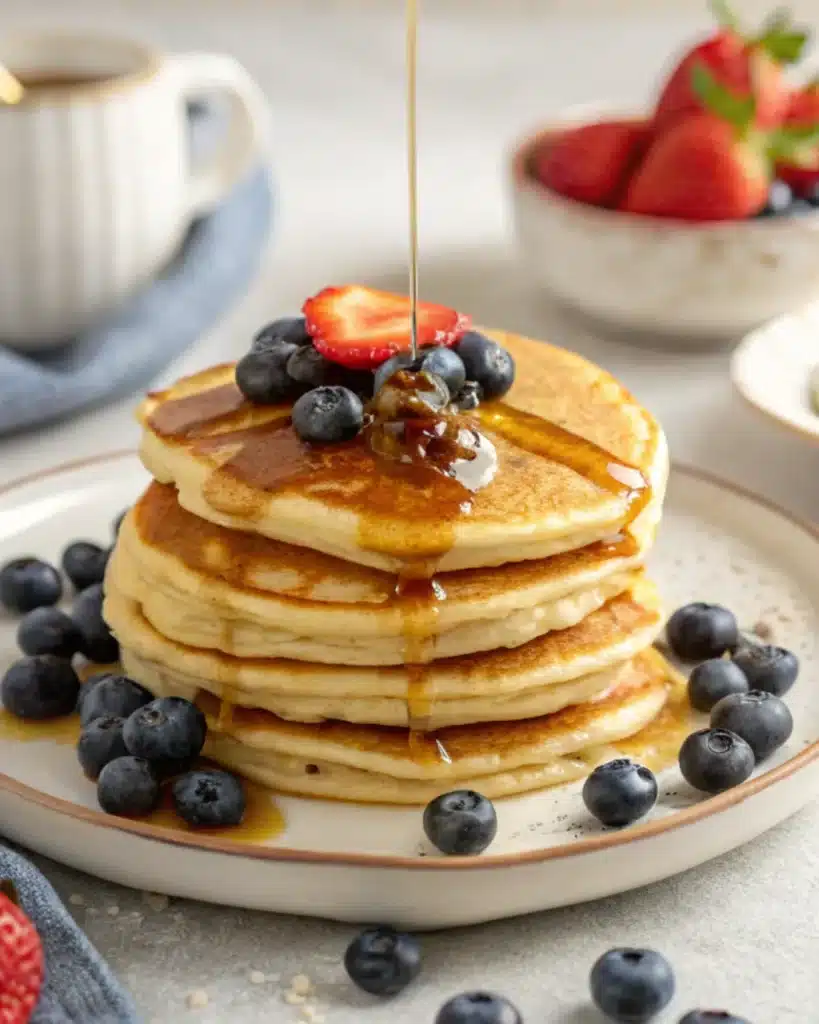
That’s what led me to create this ultimate guide. Not just a single gluten-free pancake recipe, but everything you need to flip perfect, fluffy stacks every single time—without the gluten, and without the guesswork. Whether you’re brand new to gluten-free cooking or you’ve been trial-and-error-ing your way through flat, dense disasters, this guide is here to help you win back your mornings.
Ready to whip up the fluffiest gluten-free pancakes of your life? Let’s get mixing.
Looking for inspiration? Try these soft and rich gluten-free chocolate cupcakes for dessert or snack-time indulgence after your pancake breakfast.
Table of Contents
Table of Contents
Understanding the Gluten-Free Pancake Basics
What Does “Gluten-Free” Really Mean?
At its core, “gluten-free” means removing the protein found in wheat, barley, and rye—gluten—which gives traditional pancake batter its stretch and fluff. But once you strip that out, the challenge becomes how to recreate the texture we all grew up loving.
Gluten-free isn’t just for folks with celiac disease anymore. More people are choosing wheat-free breakfasts because of allergies, inflammation, or just feeling better without it. But you don’t have to miss out on Saturday morning pancakes because of dietary restrictions. In fact, you can make them better than ever.
When building a gluten-free pancake recipe, you’re not just swapping flours—you’re creating a balance of ingredients that hold together, rise right, and taste delicious. The secret? Understanding what each component does and how it replaces traditional elements.
Why Gluten-Free Pancakes Are Gaining Popularity
It’s not just about health—it’s about taste, texture, and control over your ingredients. With store-bought gluten-free pancake mixes, you’re often paying a premium for something that tastes like cardboard and cooks like paste. But with a homemade mix? You decide the sweetness, the texture, the blend.
Trendy or not, gluten-free pancakes are showing up on brunch menus and family tables more than ever. That’s because they offer flexibility. You can use almond flour for protein, oat flour for a warm flavor, or even blend your own for a more personal twist.
Plus, gluten-free pancakes are incredibly forgiving. Once you understand the flour ratios and moisture levels (more on that later), you’ll have a recipe you can tweak endlessly without stress. It’s no longer about compromise—it’s about creating something new that’s still rooted in comfort.
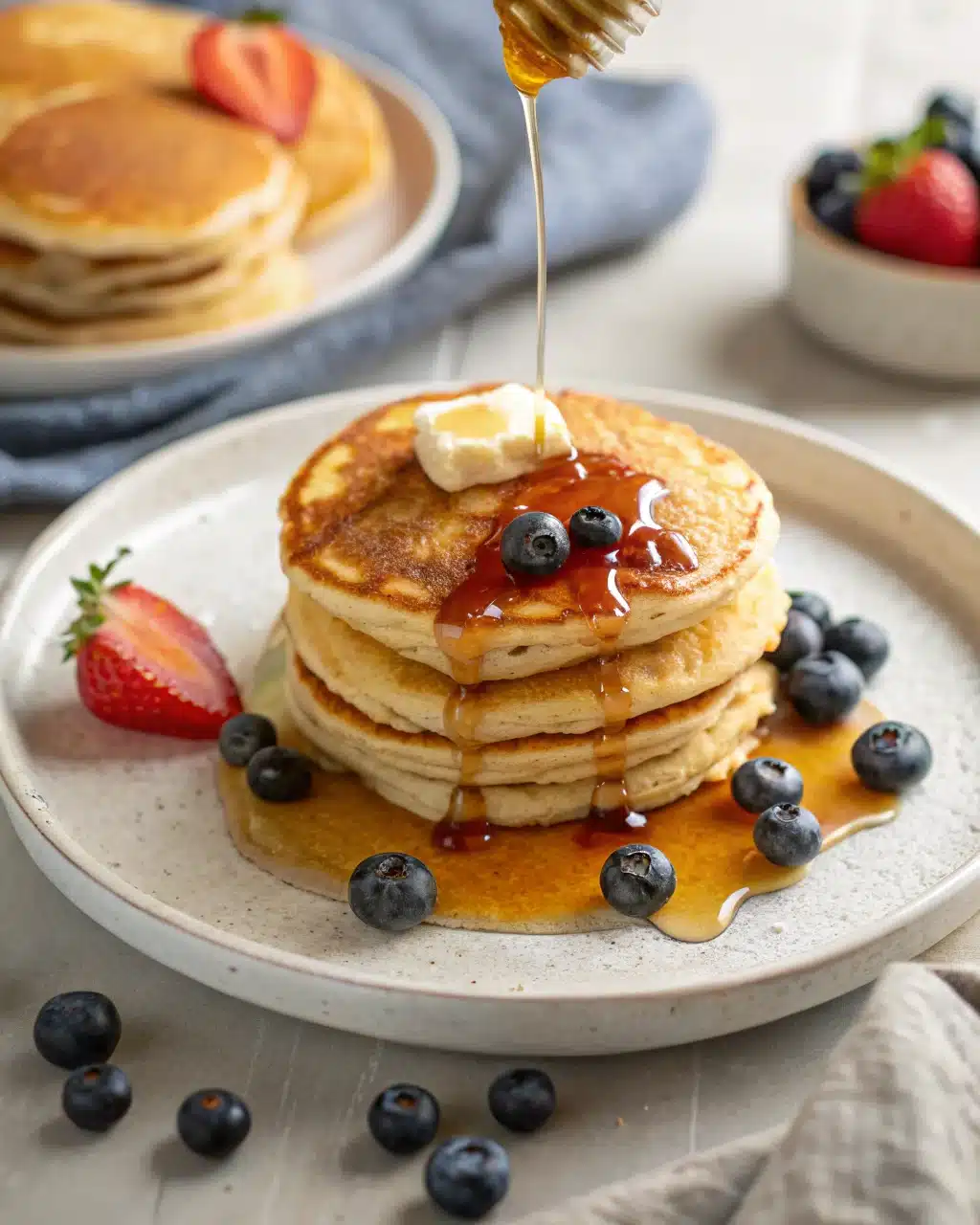
Gluten-Free Pancake Recipe: The Ultimate Guide to Light, Fluffy Mornings
Ingredients
Method
- In a large mixing bowl, whisk together the egg (or vegan egg substitute), granulated sugar, vanilla extract, and vegetable oil until smooth and fully combined.
- In a separate bowl, mix the gluten-free flour, xanthan gum (skip if your blend already includes it), baking powder, and salt. Gradually stir the dry mixture into the wet ingredients and mix until everything is well incorporated.
- Slowly pour in the milk and continue stirring until the batter is smooth. If you prefer thinner pancakes, add 1 to 2 tablespoons of extra milk.
- Using a ¼ cup measure, scoop the batter and pour it onto a lightly greased, preheated griddle or skillet. For best results, cook at 350°F for even browning.
- Let the pancakes cook until bubbles appear on the surface and the edges begin to firm up. Flip and continue cooking until the second side is golden brown and cooked through.
- Serve warm and top with your favorite toppings—like butter, maple syrup, fresh fruit, or a dollop of nut butter. Enjoy every bite!
Nutrition
Notes
Tried this recipe?
Let us know how it was!Must-Have Ingredients for a Gluten-Free Pancake Recipe
Creating the perfect gluten-free pancake recipe is like solving a delicious puzzle—you need the right pieces in just the right amounts. Skip one or sub the wrong way, and your pancakes turn out gummy, dry, or crumbly. But with the right combo of flours, binders, and flavor agents, you’ll be flipping golden stacks that taste just like the ones from your childhood—if not better.
Let’s break down the real MVPs of gluten-free pancake perfection.
Best Gluten-Free Flours for Pancakes (Rice, Almond, Buckwheat, Oat)
When it comes to gluten-free flour, one size never fits all. Here are the top contenders to mix and match:
| Flour Type | Texture | Flavor | Best Use |
|---|---|---|---|
| Rice Flour | Light and fine | Neutral | Base flour for softness |
| Almond Flour | Slightly coarse | Nutty and rich | Adds protein and moisture |
| Buckwheat Flour | Dense and hearty | Earthy | Great for rustic pancake variations |
| Oat Flour | Soft and tender | Naturally sweet | Adds chewiness and flavor depth |
| Sorghum or Teff | Slightly gritty | Mild and earthy | Balanced structure in flour blends |
Pro Tip: Most store-bought blends (like Pillsbury or Bob’s Red Mill) already contain xanthan gum or guar gum, which helps bind everything together. Always check the label before adding extra.
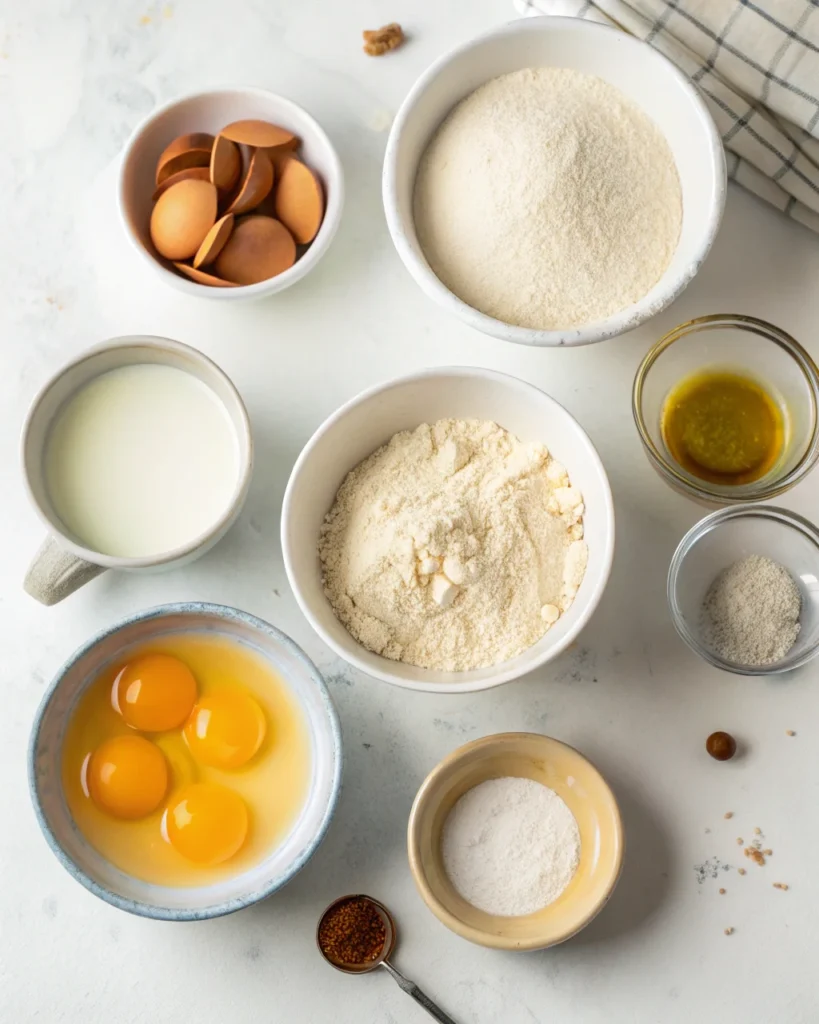
Essential Additions: Binders, Moisturizers, and Leavening Agents
It’s not just the flour that makes or breaks your batter. These ingredients are essential for texture, structure, and flavor:
- Xanthan Gum or Guar Gum: Acts like gluten in holding your batter together. If your flour mix doesn’t have it, you’ll need about ¼ teaspoon per cup of flour.
- Eggs or Egg Substitutes: Eggs add richness and binding. Going egg-free? Use a flax egg, applesauce, mashed banana, or Bob’s Red Mill egg replacer.
- Milk or Dairy-Free Milk: The choice here affects texture and taste. Almond, oat, and coconut milk all work great. Add a splash more for thinner pancakes.
- Oil or Melted Butter: Adds moisture and richness. Vegetable oil is neutral; coconut oil gives a hint of sweetness.
- Baking Powder: The magic lifter. A tablespoon will give your pancakes that essential fluff. Make sure it’s labeled gluten-free!
- Vanilla Extract and Sugar: For a classic pancake flavor. Adjust sugar to taste if adding sweet toppings.
Step-by-Step Gluten-Free Pancake Recipe Preparation
You’ve got the ingredients lined up. Now let’s turn them into a stack of warm, fluffy pancakes that could rival anything from a weekend diner. The beauty of this gluten-free pancake recipe is that it’s just as easy as a traditional one—you just need a few technique tweaks to make up for the lack of gluten.
Let’s break it down into a foolproof, no-fuss process.
How to Mix Wet and Dry Ingredients the Right Way
Getting your batter smooth without overmixing is key. Gluten-free flours can become thick or sticky if stirred too much. Here’s how to mix like a pro:
- Whisk Wet Ingredients First:
In a large bowl, combine your egg (or replacer), milk of choice, oil or melted butter, sugar, and vanilla extract. Whisk until smooth. This builds a solid flavor base. - Mix Dry Ingredients Separately:
In another bowl, sift together your gluten-free flour, baking powder, salt, and xanthan gum (if needed). Sifting helps avoid lumps and ensures even rising. - Combine Gently:
Pour the dry ingredients into the wet bowl. Use a spatula or wooden spoon to mix until just combined. It’s okay if the batter has a few lumps—overmixing can lead to dense pancakes. - Adjust Consistency:
If your batter is too thick, add 1–2 tablespoons of milk to loosen it. It should pour slowly off a spoon, not drip like water or clump like cookie dough.
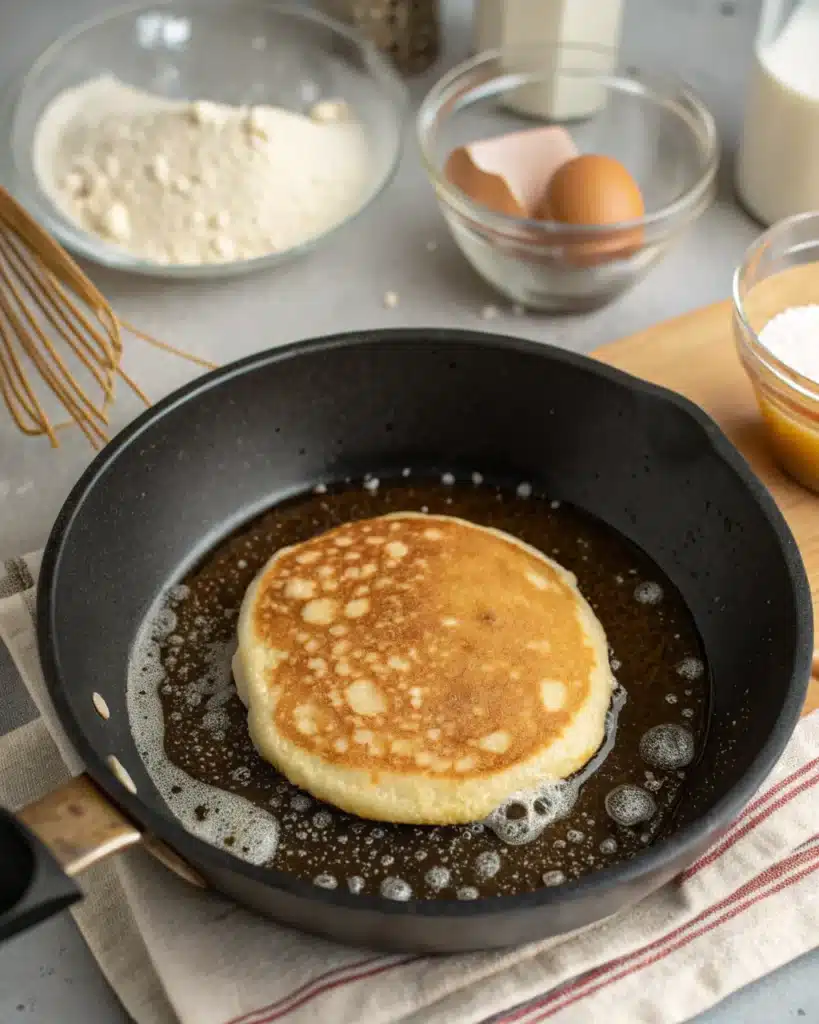
Tips for Cooking Perfect Pancakes Without Gluten
Cooking gluten-free pancakes is where many home cooks hit a wall. But with a few smart moves, you’ll never have to scrape another sad pancake off a pan again.
- Preheat Your Griddle or Skillet:
Set your pan or griddle to medium heat (around 350°F if using an electric griddle). Let it warm for 5 minutes before adding batter. - Grease Lightly:
Use butter, oil, or spray—but don’t overdo it. Too much fat can lead to greasy edges or uneven browning. - Scoop with Consistency:
Use a ¼ cup measuring cup for each pancake. This keeps cooking time even and makes stacking easier. - Wait for Bubbles:
Don’t flip too early. Wait until you see bubbles forming on the surface and the edges starting to set. This means the underside is golden and ready to flip. - Flip Once—Gently:
Gluten-free pancakes are delicate. Flip carefully and cook the second side until golden brown and puffed. - Serve Immediately or Keep Warm:
Place cooked pancakes on a baking sheet in a warm (200°F) oven while you finish the batch.
Quick Checklist for Pancake Success
- Use the spoon-and-level method for flour.
- Whisk wet and dry ingredients separately.
- Don’t overmix!
- Let the batter rest for 5–10 minutes for fluffier results.
- Adjust consistency before cooking.
Making Moist and Fluffy Gluten-Free Pancakes Every Time
Let’s be honest—gluten-free pancake recipes have a bit of a reputation. Dry. Crumbly. Flat. But it doesn’t have to be that way. In fact, with a few simple tweaks, you can make pancakes that are so fluffy and moist, even the gluten-eaters at the table will be going back for seconds.
Let’s crack open the secrets.
How to Avoid Dry or Gummy Pancakes
Without gluten, you lose elasticity and structure, which is why many gluten-free pancakes either fall apart or feel like hockey pucks. Here’s how to dodge those kitchen disasters:
- Use the Right Flour Blend:
Not all gluten-free flours behave the same. A mix of rice flour with either almond, oat, or sorghum provides a light, moist base. Blends like Bob’s Red Mill 1-to-1 or Pillsbury’s gluten-free flour are great starting points. - Don’t Skip the Binder:
If your blend doesn’t have xanthan or guar gum, add ¼ teaspoon per cup of flour. This holds everything together and prevents pancakes from tearing. - Watch Your Ratios:
Too much flour or too little liquid = dry pancakes. Always start with ¾ cup of milk and add more a tablespoon at a time until the batter is smooth but not runny. - Let the Batter Rest:
Give your batter 5 to 10 minutes to rest. This allows the flour to fully absorb the liquids, creating better texture and fluff.
Moisture-Retention Tricks: Eggs, Oils, Milks, and Substitutes
Moisture isn’t just about liquids—it’s about fat and balance. Here’s what keeps things soft, tender, and heavenly:
- Eggs:
Real MVPs of moisture and structure. If you’re egg-free, go for applesauce (¼ cup per egg), mashed banana, or chia/flax eggs. - Oil or Butter:
Fat equals moisture. Stick with 2 tablespoons of neutral oil like canola or a bit of melted coconut oil for extra flavor. - Milk Matters:
Almond, oat, or coconut milk all do the job beautifully. Just make sure it’s unsweetened if you want control over the flavor. - Add-ins with Purpose:
A tablespoon of yogurt or mashed banana can transform your pancake’s texture. Just don’t overdo it or your batter gets heavy.
Pro Tip: Want ultra-moist pancakes? Add ½ teaspoon of apple cider vinegar or lemon juice to the milk. It activates the baking powder and gives your pancakes an extra lift while locking in moisture.
Best Gluten-Free Pancake Variations to Try
One of the biggest advantages of a great gluten-free pancake recipe is that it’s a blank canvas. Once you’ve mastered the base, the flavor possibilities are endless. Whether you’re working around food allergies, sticking to a vegan lifestyle, or just craving something new—this part is all about adding fun back into your flapjacks.
Let’s explore some delicious and diet-friendly twists that’ll take your gluten-free pancakes from simple to showstopping.
Dairy-Free, Egg-Free, and Vegan Options
Going gluten-free doesn’t mean sacrificing other dietary needs. In fact, these substitutions often improve the texture and flavor of your pancakes.
- Dairy-Free Pancakes:
Substitute regular milk with almond, oat, cashew, or coconut milk. For richer flavor, coconut milk is a great pick—especially in tropical or chocolate-based recipes. - Egg-Free Pancakes:
Skip the eggs and try these:- Flax Egg: 1 tablespoon ground flaxseed + 3 tablespoons water
- Chia Egg: Same ratio as flax, gives a nuttier texture
- Mashed Banana or Applesauce: Adds moisture and flavor
- Vegan Pancakes:
Combine the two approaches above. Use plant-based milk, flax/chia egg, and coconut oil for richness. Add a touch of maple syrup or cinnamon to sweeten naturally.
💡 Try this combo:
- Almond milk
- Flax egg
- Coconut oil
- Dash of cinnamon + splash of vanilla
Your vegan stack will be so fluffy, nobody will miss the eggs or dairy.
Flavor Additions: Banana, Chocolate Chip, Blueberry, and More
Why stop at plain? Pancakes are the perfect base for mix-ins that bring texture and flavor to life. Here are a few irresistible variations:
1. Banana Bread Pancakes
- Add ½ mashed banana to the batter
- Sprinkle in a dash of cinnamon and a few chopped walnuts
- Drizzle with maple syrup and extra banana slices
2. Chocolate Chip Delight
- Stir in ¼ cup of semi-sweet gluten-free chocolate chips
- Top with a light dusting of cocoa powder and whipped cream
- Works beautifully with coconut milk in the batter
3. Blueberry Bliss
- Gently fold in fresh or frozen blueberries (1/3 cup per batch)
- Avoid overmixing or the berries will break and color the batter
- Add lemon zest to brighten the flavor
4. Pumpkin Spice (Fall Favorite)
- Add ¼ cup canned pumpkin and ½ tsp pumpkin pie spice
- Increase sugar slightly to balance the earthy flavor
- Serve with toasted pecans and maple syrup
5. Peanut Butter Protein Pancakes
- Mix in 1 tbsp peanut butter and a scoop of vanilla protein powder
- Thin the batter with extra almond milk as needed
- Top with banana slices and a drizzle of honey
Quick Flavor Booster Table
| Add-In | Amount per Batch | Pairs Well With |
|---|---|---|
| Banana (mashed) | ½ medium banana | Cinnamon, walnuts |
| Blueberries | ⅓ cup | Lemon zest, honey |
| Chocolate Chips | ¼ cup | Vanilla, coconut milk |
| Pumpkin Purée | ¼ cup | Nutmeg, pecans |
| Cocoa Powder | 1 tbsp | Peanut butter, maple syrup |
Don’t miss our gluten-free vanilla cupcakes for another sweet, fluffy treat that’s perfect for brunch or birthdays. They’re a great complement to fruity pancakes like blueberry or banana.
Storage and Freezing Tips for Gluten-Free Pancakes
You’ve flipped your last pancake and your kitchen smells amazing—but what about the leftovers? With the right storage techniques, your gluten-free pancake recipe can keep delivering easy, satisfying breakfasts all week long. Whether you’re meal prepping or just made too many, proper storage ensures you won’t lose moisture or flavor.
Let’s talk strategy.
How to Store Pancakes Without Losing Texture
Storing gluten-free pancakes is all about protecting their softness while preventing sogginess. Here’s how to keep them fresh:
- Cool Completely Before Storing:
Let your pancakes sit on a cooling rack for 10–15 minutes before packing. Storing them while warm leads to condensation, which causes mushy texture. - Refrigeration Method:
- Stack pancakes with parchment paper between each one
- Place in an airtight container or zip-top bag
- Store in the fridge for up to 4 days
- Best Way to Reheat:
- Microwave: 20–30 seconds for soft pancakes
- Toaster: Adds crisp edges
- Skillet: Heat over low for 1–2 minutes each side
- Avoid Reheating in Bulk:
Heat only what you need to keep texture at its best.
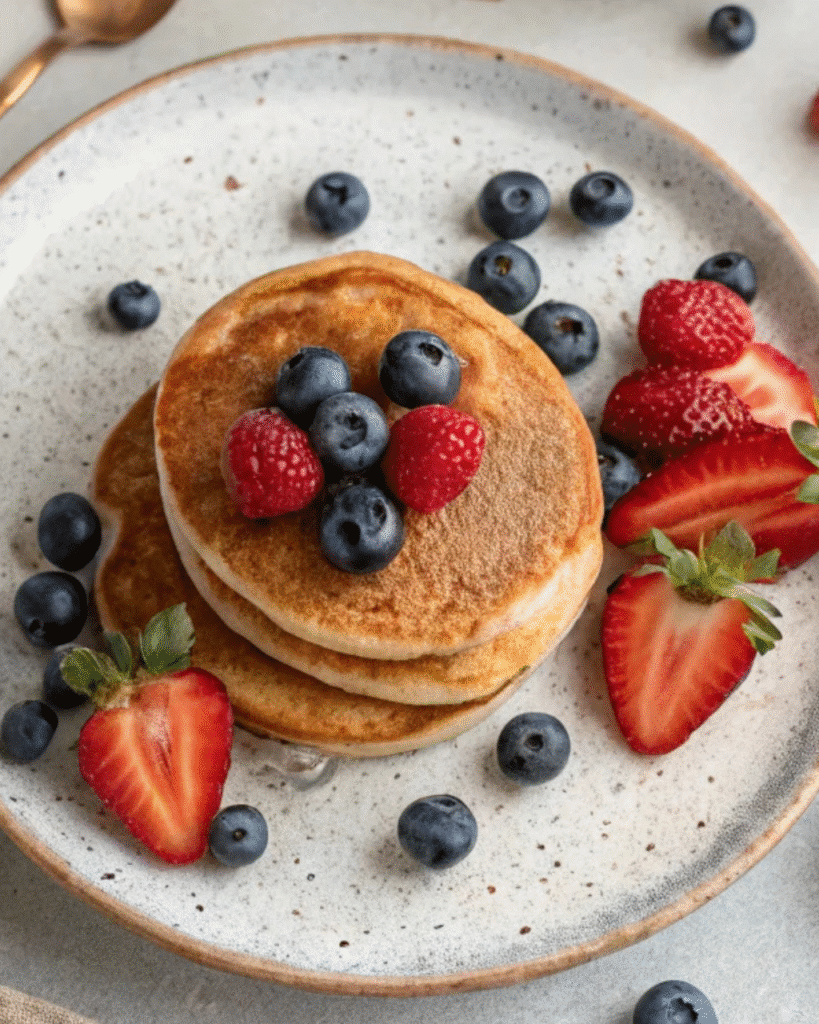
Freezer-Friendly Pancakes: Meal Prep the Smart Way
Want to save time and always have pancakes ready on busy mornings? Freezing is your friend. Done right, they’ll taste just as fresh as the day you made them.
How to Freeze Gluten-Free Pancakes:
- Let pancakes cool completely
- Lay them flat on a parchment-lined baking sheet
- Flash freeze for 10 minutes
- Transfer to a freezer-safe bag or airtight container
- Label with the date
They’ll keep for up to 2 months in the freezer.
To Reheat from Frozen:
- Microwave: 30–45 seconds
- Toaster: Perfect for crisping without drying
- Oven: 350°F for 5–6 minutes
Meal Prep Tip:
Double your batch on weekends, freeze the extras, and your weekday breakfast will take less time than pouring a bowl of cereal.
Common Gluten-Free Pancake Mistakes (and How to Fix Them)
Even with the best gluten-free pancake recipe, things can go sideways—flat stacks, rubbery bites, weird textures. Trust me, I’ve been there. But don’t worry: these issues aren’t deal-breakers. They’re just signs something small needs tweaking.
Let’s walk through the most common gluten-free pancake problems and how to fix them fast.
Why Pancakes Fall Apart or Taste Weird
1. They’re Falling Apart on the Griddle
Cause: Not enough binding agent (like xanthan gum or egg)
Fix: Add ¼ tsp xanthan gum (if not already in your flour mix) or 1 extra egg/substitute. Also, let your batter rest 5–10 minutes to hydrate properly.
2. They Taste Gritty or Chalky
Cause: Poor-quality flour blend or improper flour measuring
Fix: Use spoon-and-level method to measure flour. Switch to a smoother blend like Bob’s Red Mill 1-to-1 or Pillsbury GF.
3. They’re Too Dense or Gummy
Cause: Overmixing or not enough leavening
Fix: Mix until just combined—lumps are okay. Check your baking powder is fresh and gluten-free.
4. They Have a Bitter Aftertaste
Cause: Too much baking powder or not enough sweetener
Fix: Reduce baking powder slightly or add a pinch of sugar or vanilla to round out flavors.
How to Troubleshoot Texture and Flavor Issues
| Issue | Likely Cause | Quick Fix |
|---|---|---|
| Pancakes break apart | Not enough binder (egg or xanthan gum) | Add ¼ tsp xanthan gum or 1 extra egg |
| Too thick or dry | Not enough liquid or too much flour | Add milk 1 tbsp at a time |
| Weird taste | Stale flour or expired ingredients | Use fresh mix, add vanilla or sugar |
| Raw inside but brown outside | Heat too high | Lower heat and cook slightly longer |
| Pancakes are rubbery | Overmixed batter | Mix until just combined |
Pro Tip: Always do a small test pancake first. If it sticks, falls apart, or tastes off, adjust your batter before committing to the whole batch.
Nutrition, Calories, and Serving Suggestions
Let’s be honest—pancakes are comfort food. But that doesn’t mean they can’t fit into a health-conscious lifestyle. A solid gluten-free pancake recipe can be both delicious and balanced—especially when you’re intentional about your ingredients and what goes on top.
Let’s break down what you’re really eating (and how to elevate it).
Nutrition Facts for Standard Gluten-Free Pancakes
Here’s a general breakdown of one average-sized gluten-free pancake using the recipe we’ve built in this guide:
| Nutrient | Per Pancake |
|---|---|
| Calories | 150–170 kcal |
| Carbs | 16–20g |
| Protein | 4–6g |
| Fat | 5–7g |
| Fiber | 1–2g |
| Sugar | 3–4g |
| Sodium | 120–140mg |
Factors that affect nutrition:
- Flour blend (almond = higher protein, oat = higher fiber)
- Milk choice (almond vs. coconut vs. whole)
- Add-ins like fruit, chocolate chips, or syrups
Tip: Want more protein? Add a scoop of gluten-free protein powder or an extra egg. Need more fiber? Mix in some ground flax or use oat flour.
Pairing Ideas: Healthy Toppings and Sides
Great gluten-free pancakes deserve great company. Here are some delicious and healthy ways to round out your breakfast plate:
Toppings That Balance Flavor & Nutrition
- Fresh Fruit: Blueberries, strawberries, sliced bananas, or mango
- Nut Butters: Peanut, almond, or cashew for added protein
- Yogurt Swirl: Greek or plant-based yogurt for creaminess
- Pure Maple Syrup or Honey: In moderation—try warming it for extra flavor
- Coconut Cream: Whipped and chilled as a dairy-free topping
Savory Pairings for a Complete Meal
- Crispy Bacon or Turkey Sausage: For that salty-sweet contrast
- Scrambled Eggs or Vegan Tofu Scramble: Adds protein
- Frittata Slices or Hash Browns: To make it a hearty brunch
Build-Your-Own Pancake Board Idea:
Arrange mini pancakes on a platter with bowls of toppings—perfect for brunch parties or kids’ mornings. It’s interactive, fun, and totally customizable
Bonus Tips from Gluten-Free Experts
Even the best gluten-free pancake recipe can be taken up a notch with insights from those who live and breathe gluten-free living. Whether you’re newly diagnosed with celiac or just experimenting with a gluten-free lifestyle, these tips will give you confidence in every batch.
Tips from Gluten-Free Cooks and Bloggers
We reached into the gluten-free community and pulled out some of the smartest, tried-and-true tricks that home cooks swear by:
1. Audrey Roberts (Mama Knows Gluten Free)
“Always rest your batter! Gluten-free flours take time to absorb liquid. Letting your mix sit 10 minutes makes the difference between gritty and fluffy.”
2. The Gluten Free Blogger
“Don’t get stuck on one flour blend—try rotating between oat flour, sorghum, and almond for different textures. You’ll find your favorite combo over time.”
3. Minimalist Baker
“For vegan and gluten-free combos, keep pancakes small. Smaller circles are easier to flip and hold together better.”
Recommended Products, Tools, and Brands
Here are a few kitchen allies that’ll help you master gluten-free pancakes every time:
| Tool/Product | Why It’s Great |
|---|---|
| Electric Griddle | Even cooking, no hot spots, great for large batches |
| Bob’s Red Mill 1:1 Flour | Consistent, reliable, includes xanthan gum |
| Pillsbury Gluten-Free Mix | Soft texture, easy-to-find, works for waffles too |
| OXO Flip Spatula | Thin and flexible for delicate gluten-free flipping |
| Coconut Oil Spray | Non-stick and dairy-free |
Pro Tip: Invest in a non-stick griddle and a good measuring cup set. Accuracy is everything when baking without gluten.
Conclusion
Pancakes aren’t just breakfast—they’re nostalgia on a plate. And with the right gluten-free pancake recipe, you don’t have to miss out on the joy, the fluff, or the flavor. Whether you’re going gluten-free by necessity or choice, this guide gives you everything you need to flip golden, satisfying pancakes that win over every table.
Remember: it’s not about mimicking traditional pancakes—it’s about building new traditions, one delicious stack at a time.
Don’t miss our other gluten-free favorites like buckwheat pancakes, almond flour waffles, and banana oat muffins to complete your breakfast lineup.
Follow us on Facebook & Pinterest for more gluten-free dessert ideas and community fun!
For more delicious gluten-free recipes, visit our website at The Savory Hearth.
FAQ: Gluten-Free Pancake Recipe Questions Answered
What is the best flour for gluten-free pancakes?
The best gluten-free flour for pancakes depends on your taste and texture preferences. For soft and fluffy pancakes, a rice flour blend (like Bob’s Red Mill 1-to-1 or Pillsbury GF) works great. For more flavor and nutrients, mix in oat flour, almond flour, or sorghum. Always choose a blend that includes xanthan gum or add it separately for structure.
What is a good substitute for flour in pancakes?
If you’re looking to replace traditional flour entirely, try:
Oat flour for a chewy texture
Almond flour for richness
Coconut flour (in small amounts) for fiber and sweetness
Mashed banana or pumpkin can replace part of the flour for extra moisture
These work best in combination rather than alone for balance.
How do you make gluten-free more moist?
Moisture is all about balance. Use enough fat (like oil or butter), keep a proper liquid-to-flour ratio, and rest your batter before cooking. Adding ingredients like yogurt, mashed banana, or even a splash of vinegar in milk can improve moisture and texture significantly.

4 thoughts on “Gluten-Free Pancake Recipe: The Ultimate Guide to Light, Fluffy Mornings”